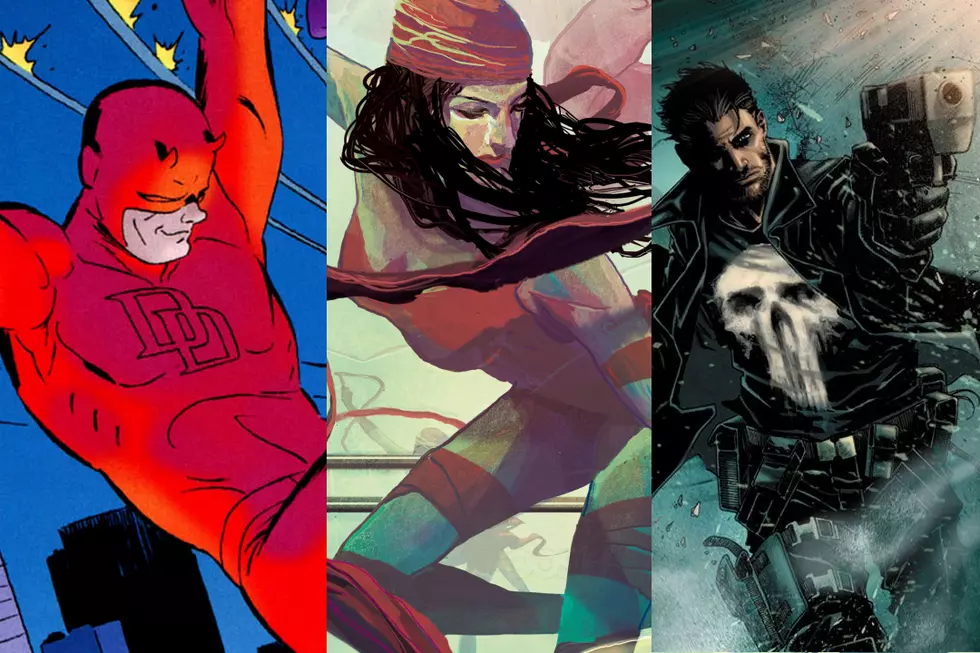
ComicsAlliance’s Best Comics of 2009: #1
ComicsAlliance's Best Comics of 2009 list continues, with the #1 Comic of the Year: "Asterios Polyp."

"Asterios Polyp" opens with a bolt of lightning, and to many comics fans it may seem as if cartoonist David Mazzucchelli is bursting forth at the same moment, fully formed from his own brow. True, Mazzucchelli has been moving towards this moment for almost two decades, since leaving superhero comics (a genre he visually redefined and at any time, had he wanted to, could have re-entered and re-conquered) to venture into unknown territory -- his own independent comic "Rubber Blanket," the thunderously acclaimed adaptation of Paul Auster's "City of Glass" (with writer Paul Karasik), and various short works. Still, after all that time, I would wager that most comics readers, when asked to think of Mazzucchelli, think of this:

or this:

which is an awfully long way from this:

Both Mazzucchelli and the atmosphere of American Comics have been growing and changing over the last 20 years, and there's almost a sense that they are finally ready for each other. That we, as a collective audience, have finally proven ourselves worthy of one of our best cartoonists, and he has in turn rewarded us with his greatest work to date.
"Asterios Polyp" is so beautiful, so dense, and so immediately and endlessly engaging that it's hard to approach it as anything other than some hard-won trophy or precious found artifact. Mazzucchelli's opus is more than a great comic. It's the kind of work that so elegantly packs meaning and feeling into each line and panel that it makes everything around it look sick in comparison.
There is a scene where two lovers meet for the first time at a party. Everyone at the party, including our two, are drawn in a distinctly different manner -- one person is a made of letters, another is a cubist rendering, another is all shading, another is all swirling lines. When the two lovers meet they are visually opposed, members of two different artistic species. As they speak, their styles intertwine. His clean blue lines meld with her red crosshatching. They take on each other's characteristics as they talk. This all takes place on two pages, in a total of eight panels. And the above description doesn't even begin to describe everything that is happening in those eight deceptively simple drawings. And this is the kind of thing that Mazzucchelli manages to pull off, elegantly, flawlessly, on every goddamn page.

There is a scene where the main character, Asterios Polyp, a world-renowned architect who has never had anything built from his designs, goes on a picnic with a mother and her son. The picnic is on a plateau overlooking a huge crater. The kid calls it "the hole". The mother says she likes to come there from time to time, to be "blown away by the sheer physicality of the place." The defining feature of a giant crater is the empty space where something else would be. What she is saying is that there is so much nothing in this space that it has become physically palpable. And she is saying it to a man world-famous and successful for having ideas for buildings that are never built.
There is a scene where an apartment catches on fire. The fingers of the fire and the outlines of the furniture are thin black lines. The smoke is opaque and gray. And everything else is pure yellow. I have no idea what deeper meaning that might contain, but it's beautiful, and a shocking use of color. The lack of any other colors is palpable. Oh -- the lack is palpable. See what I did there? I literally thought of that as I was typing it. That's what this book does to you. That's how much there is to unpack on every single page, in every single choice Mazzucchelli makes. And it isn't a chore. It just happens while you're reading the story if you're paying attention at all.
It's possible to push everything off to the side as noise or decoration, and just enjoy the surface signal of the story -- it's a moving love story, and a large part of the plot is an enjoyable "finding yourself in a small town" riff -- but nothing you push aside is actually noise. As Asterios is fond of saying in the book, "Anything that's not functional becomes decorative." And I don't believe anything about this comic is decorative. Except, when you think about it, what function can art really be said to have? Isn't it by definition all decorative, then? And if so, what does that mean? (This is what I'm talking about. This is what this book does to you. It destroys you in the best way possible.)

It's impossible to even begin to adequately unpack "Asterios" in a single essay. It is a book that rewards re-reading, whether straight through or flipping around and reconnecting with a page, a phrase, a drawing. One of the main themes (but not the only one) of the book is that life is a process of learning how to view the world, processing the information presented to you every day in the cacophony of existence, in which everything is happening at once and what you choose to pay attention to defines your reality. It is a book designed to shift and transform as it is looked at more carefully in relation to the reader's own thoughts and experiences.
There is a scene where a woman shows a man her artwork. Flattered with the attention, she is drawn as lit in a spotlight as he compliments the work -- and then, as he spirals off into his own interpretations of her work, the spotlight shifts to him. This book is Mazzucchelli's greatest achievement to date, but it has been awarded to the readers. We've earned it. The spotlight is on us now. Let's all celebrate by reading it again.

More From ComicsAlliance









